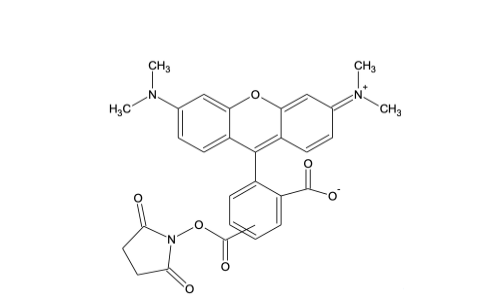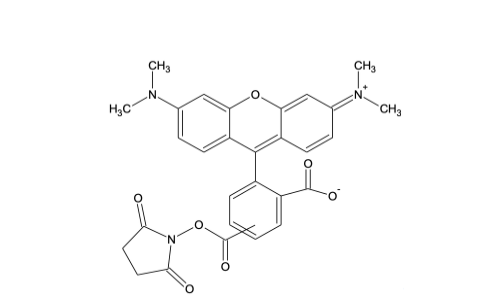5(6)-TAMRA-SE
基本信息
| 产品名称 | 5(6)-TAMRA-SE |
|---|---|
| 英文名称 | 5(6)-TAMRA-SE |
| 英文别名 | 5(6)-Carboxytetramethylrhodamine hydroxysuccinimide ester |
| 规格或纯度 | 95% |
| 运输条件 | 超低温冰袋运输 |
一般描述
Product description
Ex(nm) : 546
Em(nm) : 575
Solvent:DMF or DMSO
MW : 527.53

Succinimidyl esters are proven to be the best reagents for amine modifications because the amide bonds that are formed are essentially identical to, and as stable as the natural peptide bonds. These reagents are generally stable and show good reactivity and selectivity with aliphatic amines. There are few factors that need be considered when SE compounds are used for conjugation reaction:
1). Solvents:For the most part, reactive dyes are hydrophobic molecules and should be dissolved in anhydrous dimethylformamide (DMF) or dimethylsulfoxide (DMSO).
2).Reaction pH:The labeling reactions of amines with succinimidyl esters are strongly pH dependent. Amine-reactive reagents react with non-protonated aliphatic amine groups, including the terminal amines of proteins and the e-amino groups of lysines. Thus amine acylation reactions are usually carried out above pH 7.5. Protein modifications by succinimidyl esters can typically be done at pH 7.5-8.5, whereas isothiocyanates may require a pH 9.0-10.0 for optimal conjugations.
3).Reaction Buffers:Buffers that contain free amines such as Tris and glycine and thiol compounds must be avoided when using an amine-reactive reagent. Ammonium salts (such as ammonium sulfate and ammonium acetate) that are widely used for protein precipitation must also be removed (such as viadinlysis) before performing dye conjugations.
4). Reaction Temperature:Most conjugations are done at room temperature. However, either elevated or reduced temperature may be required for a particular labeling reaction.
Features and Biological Applications
The succinimidyl esters of 5-TAMRA, 6-TAMRA or the mixed isomers are the primary labeling reagents for the preparation orange fluorescent bioconjugates, including peptide, protein, nucleotide and nucleic acid conjugates, especially fluorescent antibodies and avidin derivatives used in immunochemistry. TMR dyes have also been widely used as acceptors for FAM fluorophores in a variety of FRET studies.
References
1. Hahn M, et al. (2001). Influence of fluorophore dye labels on the migration behavior of polymerase chain reaction-amplified short tandem repeats during denaturing capillary electrophoresis. Electrophoresis 22, 2691-700.
2. Hsu TM, et al. (2001). Genotyping single-nucleotide polymorphisms by the invader assay with dual-color fluorescence polarization detection. Clin Chem47, 1373-7.
3. Micka, K.A., et al., Twgdam validation of a nine-locus and a four-locus fluorescent str multiplex system.J Forensic Sci1999, 44, 1243-57.
Product description
Ex(nm) : 546
Em(nm) : 575
Solvent:DMF or DMSO
MW : 527.53

Succinimidyl esters are proven to be the best reagents for amine modifications because the amide bonds that are formed are essentially identical to, and as stable as the natural peptide bonds. These reagents are generally stable and show good reactivity and selectivity with aliphatic amines. There are few factors that need be considered when SE compounds are used for conjugation reaction:
1). Solvents:For the most part, reactive dyes are hydrophobic molecules and should be dissolved in anhydrous dimethylformamide (DMF) or dimethylsulfoxide (DMSO).
2).Reaction pH:The labeling reactions of amines with succinimidyl esters are strongly pH dependent. Amine-reactive reagents react with non-protonated aliphatic amine groups, including the terminal amines of proteins and the e-amino groups of lysines. Thus amine acylation reactions are usually carried out above pH 7.5. Protein modifications by succinimidyl esters can typically be done at pH 7.5-8.5, whereas isothiocyanates may require a pH 9.0-10.0 for optimal conjugations.
3).Reaction Buffers:Buffers that contain free amines such as Tris and glycine and thiol compounds must be avoided when using an amine-reactive reagent. Ammonium salts (such as ammonium sulfate and ammonium acetate) that are widely used for protein precipitation must also be removed (such as viadinlysis) before performing dye conjugations.
4). Reaction Temperature:Most conjugations are done at room temperature. However, either elevated or reduced temperature may be required for a particular labeling reaction.
Features and Biological Applications
The succinimidyl esters of 5-TAMRA, 6-TAMRA or the mixed isomers are the primary labeling reagents for the preparation orange fluorescent bioconjugates, including peptide, protein, nucleotide and nucleic acid conjugates, especially fluorescent antibodies and avidin derivatives used in immunochemistry. TMR dyes have also been widely used as acceptors for FAM fluorophores in a variety of FRET studies.
References
1. Hahn M, et al. (2001). Influence of fluorophore dye labels on the migration behavior of polymerase chain reaction-amplified short tandem repeats during denaturing capillary electrophoresis. Electrophoresis 22, 2691-700.
2. Hsu TM, et al. (2001). Genotyping single-nucleotide polymorphisms by the invader assay with dual-color fluorescence polarization detection. Clin Chem47, 1373-7.
3. Micka, K.A., et al., Twgdam validation of a nine-locus and a four-locus fluorescent str multiplex system.J Forensic Sci1999, 44, 1243-57.
相关属性
| CAS编号 | 246256-50-8 |
|---|---|
| 储存温度 | -20°C储存 |
| MDL号 | MFCD00077324 |
| 分子量 | 527.52 |
| 分子式 | C29H25N3O7 |
| 品牌 | Jinpan |

